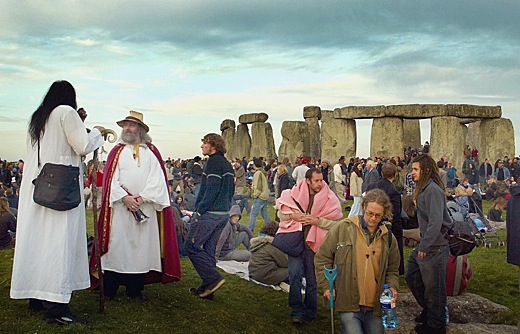 Image above: Pagans and others at dawn of the Summer Solstice at Stonehenge. From (http://speakingoffaith.publicradio.org/programs/pagans/particulars.shtml).
Image above: Pagans and others at dawn of the Summer Solstice at Stonehenge. From (http://speakingoffaith.publicradio.org/programs/pagans/particulars.shtml).
Bonfires, drum circles, dancing, candlelit meditation and other ceremonial rituals help usher in the summer solstice at the annual Pagan Spirit Gathering, now in its 30th year in the United States.
Along with celebrating the longest day of the year on Monday (June 21), this year's weeklong festival at a campground in Salem, Mo., will also feature prayers to help the Earth recover from the BP oil spill in the Gulf of Mexico.
"We always do planetary healing prayers, meditations, and ceremonies on Solstice day itself, and we will be continuing our prayers about the oil disaster," said Selena Fox, a high priestess at Circle Sanctuary, a Wisconsin-based pagan resource center.
"We will explore ways that the various organizations and traditions represented at our gathering can support relief efforts."
The most famous Solstice celebration draws tens of thousands of revelers to England's ancient Stonehenge monument every June; the Missouri festival, which runs June 20-27, will be the largest organized event in the U.S., Fox said.
Nearly 1,000 people are expected to attend from North America, Europe and Asia, including practitioners of Wicca, contemporary pagan, Druid, Celtic, Native American, Afro-Caribbean, and Taoist faiths.
The Spiritual Meaning of Solstice
By Grove Harris on 21 June 2010 in Huffington Post - (http://www.huffingtonpost.com/grove-harris/summer-solstice-a-sacred_b_619051.html)
Summer Solstice, the longest day of the year, the shortest night, and a tipping point: from here on out the days get shorter and the nights get longer. The solstice, sometimes called midsummer because by now farmers have long done their planting, is technically the first day of summer. It both ushers in the warmest season, and reminds that the season is short, slipping away day by day. For those who revere nature, summer solstice may be celebrated by a bonfire, and staying up to greet the dawn. Celebration may be a small private event, or a large communal event such as the Pagan Spirit Gathering held on beautiful rural land in Missouri, with ritual, prayers, altars and sacred space.
Celebration may be among a broader spectrum of people, such as the 35,000 who gathered at Stonehenge last year. BBC's coverage of that event included an interview "with those who appreciate the solstice the most: 'We believe it is very important for people to move with the cycles of nature, and actually feel them. If you get up early in the morning and you watch that special sunrise, you've been a part of it. The rest of the year is shaped by that. And we think it's a really healthy thing to do, and a very spiritual thing to do.'" And clearly the large crowd shared at least some of this sentiment and journeyed to one of the world's most renowned sacred spots to observe the sunrise.
For those for whom this is a religious practice, there are variations on the rituals or traditions. Some will burn a Yule wreath in a bonfire; some will dance, drum, sing, and pray. The variations are endless -- some rituals may be prescribed and ceremonial, while others will be more spontaneous: all are witnessing the turning of the wheel of the year. People attune themselves to the rhythms of the natural world and invite the seasons of waxing and waning, of birth, growth, death and renewal to reverberate more consciously in their lives.
Rituals for the day of longest light date back to ancient times, and Stonehenge is one of the most famous sites. Dating back to between 3000-1500 BCE, its main axis is aligned to the solstice sunrise. Many cultures and ethnicities have celebrated, from ancient Roman celebrations of Vesta to feast days in many cultures. In contemporary Goddess spirituality, the American writer Starhawk offers this litany for ritual:
This is the time of the rose, blossom and thorn, fragrance and blood. Now on this longest day, light triumphs, and yet begins the decline into the dark. The Sun King grown embraces the Queen of Summer in the love that is death because it is so complete that all dissolves into the single song of ecstasy that moves the worlds. So the Lord of Light dies to Himself, and sets sail across the dark seas of time, searching for the isle of light that is rebirth. We turn the Wheel and share his fate, for we have planted the seeds of our own changes and to grow we must accept even the passing of the sun. (The Spiral Dance, HarperCollins, 1999, p. 205)
While Pagans hold religious ritual on the solstice, there are many public celebrations that also acknowledge the turning of the wheel of the year. Summer is widely seen as a good reason to celebrate! In Detroit, the 2010 River Days festival culminates with fireworks on the solstice, meeting fire with fire. Such celebrations build community and focus on the pleasures of the warm season, but without a religious intention.
Honoring the solstice can remind us just how precious each day and season is, because the truth of its passing away is also acknowledged. Gifts need to be appreciated, not taken for granted. Some will use their religious ritual to raise energy for healing, for re-aligning and redressing environmental wrongs, or for strengthening the sense of being part of nature, not set apart and individual, but interconnected in a larger whole, including the past, present and future. Such is the power of participating in the turning of the wheel of the year.
.
No comments :
Post a Comment